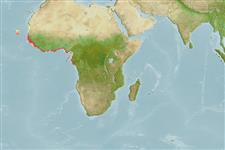>
Eupercaria/misc (Various families in series Eupercaria) >
Lethrinidae (Emperors or scavengers) > Lethrininae
Etymology: Lethrinus: Greek, lethrinia, a fish pertaining to genus Pagellus.
More on author: Valenciennes.
Environment: milieu / climate zone / depth range / distribution range
Ökologie
seewasser riff-verbunden; standorttreu; tiefenbereich 1 - 50 m (Ref. 2683). Tropical; 20°N - 5°S
Eastern Central Atlantic: Senegal to Gabon; also Cape Verde, São Tome-Principe Islands, and Rolas Islands. There is little doubt that only a single species of Lethrinus exists in the tropical western Atlantic.
Length at first maturity / Size / Gewicht / Alter
Maturity: Lm 22.8, range 21 - ? cm
Max length : 50.0 cm TL Männchen/unbestimmt; (Ref. 2295); common length : 30.0 cm TL Männchen/unbestimmt; (Ref. 2295)
Rückenflossenstacheln (insgesamt): 10; Rückenflossenweichstrahlen (insgesamt): 9; Afterflossenstacheln 3; Afterflossenweichstrahlen: 8. The outer surface of the maxilla is smooth, without a knob or pronounced longitudinal ridge. Inner surface of the pectoral fin axil without scales. Overall color is olive green or brown and pinkish. The cheeks have a network of fine reticulations below the eye.
Found in shallow coastal waters (Ref. 2263). Feeds mainly on bottom-dwelling invertebrates. Marketed fresh (Ref. 171), smoked and dried salted (Ref. 2295). Abundant during the winter months (Ref. 2683).
Life cycle and mating behavior
Geschlechtsreife | Fortpflanzung | Ablaichen | Eier | Fecundity | Larven
Carpenter, K.E. and G.R. Allen, 1989. FAO Species Catalogue. Vol. 9. Emperor fishes and large-eye breams of the world (family Lethrinidae). An annotated and illustrated catalogue of lethrinid species known to date. FAO Fish. Synop. 125(9):118 p. Rome: FAO. (Ref. 2295)
IUCN Rote Liste Status (Ref. 130435)
Bedrohung für Menschen
Harmless
Nutzung durch Menschen
Fischereien: kommerziell
Mehr Information
ReferenzenAquakulturAquakultur ProfilZuchtlinienGenetikElectrophoresesVererbbarkeitKrankheitenVerarbeitungNutrientsMass conversion
PartnerBilderStamps, Coins Misc.LauteCiguateraGeschwindigkeitSchwimmstilKiemenoberflächeOtolithsGehirngrößeSehfähigkeit
Tools
Zusatzinformationen
Download XML
Internet Quellen
Estimates based on models
Preferred temperature (Ref.
123201): 24.4 - 28, mean 26.6 °C (based on 60 cells).
Phylogenetic diversity index (Ref.
82804): PD
50 = 0.5000 [Uniqueness, from 0.5 = low to 2.0 = high].
Bayesian length-weight: a=0.01514 (0.00934 - 0.02453), b=2.95 (2.82 - 3.08), in cm total length, based on LWR estimates for this species & Genus-body shape (Ref.
93245).
Trophic level (Ref.
69278): 3.5 ±0.46 se; based on food items.
Widerstandsfähigkeit (Ref.
120179): mittel, Verdopplung der Population dauert 1,4 - 4,4 Jahre. (Assuming tm=2).
Fishing Vulnerability (Ref.
59153): Moderate vulnerability (40 of 100).
Climate Vulnerability (Ref.
125649): High to very high vulnerability (74 of 100).
Nutrients (Ref.
124155): Calcium = 42.1 [30.4, 57.1] mg/100g; Iron = 0.808 [0.552, 1.119] mg/100g; Protein = 20.1 [17.5, 22.2] %; Omega3 = 0.123 [0.090, 0.164] g/100g; Selenium = 41.4 [23.3, 61.5] μg/100g; VitaminA = 31.9 [6.9, 162.8] μg/100g; Zinc = 2.21 [1.73, 2.75] mg/100g (wet weight);
